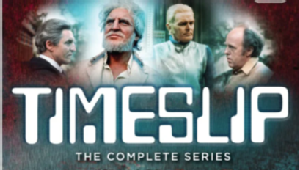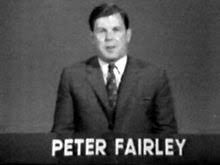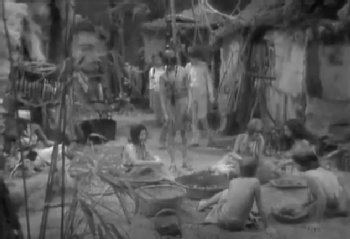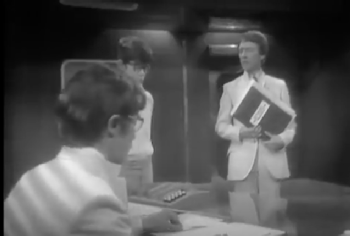Year of the Burn Up
 Broadcast between 1970 and 1971, the British children's science fiction drama series Timeslip was notable for exploring the ethical issues underlying scientific developments. Through four distinct storylines, a background story arc followed the efforts of teenagers Liz Skinner and Simon Randall to return home after an accidental passage through a “time barrier”, while simultaneously gaining insights into the activities of the sinister "Ministry for Forward Development".
Broadcast between 1970 and 1971, the British children's science fiction drama series Timeslip was notable for exploring the ethical issues underlying scientific developments. Through four distinct storylines, a background story arc followed the efforts of teenagers Liz Skinner and Simon Randall to return home after an accidental passage through a “time barrier”, while simultaneously gaining insights into the activities of the sinister "Ministry for Forward Development".
The first story, set in the wartime past, explores the consequences of radar and laser technology development. The second, set in a possible future, considers the ideas of cryogenics, longevity and intelligence enhancement treatments, as well as the risks of adopting an amoral, unemotional logic. The third, a sideways step into an alternate possible future, explores a world in which climate change advances unchecked. The final story, set in the then-present, considers the consequences of human cloning, and what steps might be required to avoid the extremes of the alternate futures the characters had seen. Throughout, questions of scientific ethics are framed through the interactions between intellectual science-enthusiast Simon and instinctual, emotional Liz, emphasised by meeting possible incarnations of their own adult selves in the future scenarios.
An Exercise in Ethics
As always with children’s science fiction, the principle objective of the series was entertainment, and it must be considered in that light. Nonetheless, Timeslip interests me both for its explicit engagement with scientific ethics and the negative nature of its warning against unchecked scientific development. These topics are common amongst adult science fiction, but relatively rare amongst work aimed at juvenile audiences; to place this in context, this series appeared just four years after Thunderbirds and simultaneously with Jon Pertwee’s incarnation of Doctor Who - in both of which science and technology is often portrayed as a source of wonder and solutions to problems. While the Third Doctor’s storylines occasionally warned of the dangers of technology in the context of industrial profit-seeking (e.g. “Colony in Space”, “The Green Death”) they were rarely overtly anti-scientific on general principles, with the Doctor and other characters seeking their own scientific solutions to the profit-driven problems. By contrast, there is no clearly positive scientific representation in Timeslip - even where the motives of individuals are shown to be benign, the consequences of their actions are invariably malignant (for example brain damage sustained by Mr Skinner due to military research), or even fatal (as in the case where friendly longevity expert Dr Edith Joynton is shown decaying towards a rapid death).
 This negative presentation of scientific themes is particularly striking given the manner in which the series is introduced. Both the first story and the second began with on-screen introductions from Peter Fairley, science correspondent for the ITN television news network and presenter of commercial television's answer to the BBC's Tomorrow's World. In his introductions, he attempted to convince the audience that the Timeslip stories were plausible in the context of modern scientific thought. That assertion, regarding a link between deja vu and travel between times and alternate universes, appears to have been based on the popular (but deeply flawed and never scientifically-accepted) parapsychology book “An Experiment with Time” (Dunne 1927), which was cited by creator Ruth Boswell as an influence (in the “Behind the Barrier” [1] documentary). The writers also consulted Fred and Geoffrey Hoyle (cosmologists and science fiction writers in their own right) in an attempt to find plausible explanations. While, in hindsight, it seems likely that the Hoyles were thinking in terms of fiction rather than actual contemporary scientific theory [2], it appears that the show’s creators believed their advice to be factual. Either way, the presence of a familiar, well-spoken, besuited journalist introducing the series as if it were a form of documentary doubtless influenced the young audience of the show and improved its apparent credibility.
This negative presentation of scientific themes is particularly striking given the manner in which the series is introduced. Both the first story and the second began with on-screen introductions from Peter Fairley, science correspondent for the ITN television news network and presenter of commercial television's answer to the BBC's Tomorrow's World. In his introductions, he attempted to convince the audience that the Timeslip stories were plausible in the context of modern scientific thought. That assertion, regarding a link between deja vu and travel between times and alternate universes, appears to have been based on the popular (but deeply flawed and never scientifically-accepted) parapsychology book “An Experiment with Time” (Dunne 1927), which was cited by creator Ruth Boswell as an influence (in the “Behind the Barrier” [1] documentary). The writers also consulted Fred and Geoffrey Hoyle (cosmologists and science fiction writers in their own right) in an attempt to find plausible explanations. While, in hindsight, it seems likely that the Hoyles were thinking in terms of fiction rather than actual contemporary scientific theory [2], it appears that the show’s creators believed their advice to be factual. Either way, the presence of a familiar, well-spoken, besuited journalist introducing the series as if it were a form of documentary doubtless influenced the young audience of the show and improved its apparent credibility.
The Burn Up
From a modern perspective, with the Damocles’ sword of global climate change hanging over us, perhaps the most interesting scenario - and an informative example to look at - is the third serial: “The Year of the Burn Up”. Set twenty-years into the then-contemporary future (i.e. around 1990), the story visits a Britain which is being overrun by tropical jungle and in which water is becoming impossibly scarce, largely as a result of a government-sanctioned Masterplan to modify world climate, controlled by a group of technocrats. As a character tells us: "The overall European plan allows for a rise of temperature to 100 degrees over the British Isles during geographic reconstruction. Later we shall return to a steady 60". The melting of the ice caps has led to the flooding of Liverpool, while the population of the UK has been moved into six large metropolises. An adult version of Liz who has embraced her emotional side leads an illegal group of artistic and free-thinking "misfits" - drop-outs from technological society. She speaks of the age of technocratic development with disgusted scorn and is favourably contrasted against both an alternate version of herself who had rejected emotion in the previous serial and the technocratic adult version of Simon, now known as Controller 2957.
 It is striking that in the context of this storyline, there is no clear solution to the climate change - it is both deliberately triggered and has already progressed too far to be reversible. While a character tries to derail “the Master Plan”, he does so through selfish motives, in search of revenge, and his actions are disastrous. The rebellious artistic colony seeks only the freedom to pursue their own interests without government oversight, but is dying from lack of water, as are the plants they nuture and depend upon. And Future-Simon, Controller 2957, has been stripped of both identity and volition: while sympathetic to his old friend, he is deeply involved in the Plan and unable to stop it, even should he want to. Instead, the only hope for the future is for the protagonists to return to their own time and prevent the Plan’s inception.
It is striking that in the context of this storyline, there is no clear solution to the climate change - it is both deliberately triggered and has already progressed too far to be reversible. While a character tries to derail “the Master Plan”, he does so through selfish motives, in search of revenge, and his actions are disastrous. The rebellious artistic colony seeks only the freedom to pursue their own interests without government oversight, but is dying from lack of water, as are the plants they nuture and depend upon. And Future-Simon, Controller 2957, has been stripped of both identity and volition: while sympathetic to his old friend, he is deeply involved in the Plan and unable to stop it, even should he want to. Instead, the only hope for the future is for the protagonists to return to their own time and prevent the Plan’s inception.
(Images: the rich, organic mise-en-scène in the representation of the artistic colony is contrasted with the sterility and emptiness of a technocratic office in London in "Year of the Burn Up")
 The relevance of this message to the children of the time is clear, and would be equally clear to an equivalent young audience of today: action (or inaction) underway now will have repercussions in decades to come, and these could be devastating not only to human society but also to the world in which we live. While this is a familiar message in these days of school strikes and global action, “The Year of the Burn Up” is a relatively early entry into the genre of climate fiction or eco-science fiction (see Ashley 2020 for a good overview), predating the mainstream movie Silent Running (which had similar themes) by more than a year. Indeed, this particular serial was highlighted in the “Behind the Barrier” documentary for its prescience.
The relevance of this message to the children of the time is clear, and would be equally clear to an equivalent young audience of today: action (or inaction) underway now will have repercussions in decades to come, and these could be devastating not only to human society but also to the world in which we live. While this is a familiar message in these days of school strikes and global action, “The Year of the Burn Up” is a relatively early entry into the genre of climate fiction or eco-science fiction (see Ashley 2020 for a good overview), predating the mainstream movie Silent Running (which had similar themes) by more than a year. Indeed, this particular serial was highlighted in the “Behind the Barrier” documentary for its prescience.
Science Skepticism
"I was certain that the rational application of science would lead to a better world... but it hasn't!" - Controller 2957, "Year of the Burn Up"
So how were the child viewers of the time, now adults of middle-age, influenced in their perception and views of science or scientists? My first instinct, as a scientist myself, was to suspect that the negative portrayals discussed above may have led to increased suspicion and scepticism regarding scientific innovation. However a poll of members of the series’ "official" facebook group (predominantly male, British and of an age to have watched the original broadcasts) suggests that the majority who responded (18/27) felt that Timeslip had improved their opinion of science and scientists, with the remainder (9/27) reporting that their views had not been affected either way. Three others commented more generally on the perceived educational aspects of Timeslip, or its role in inspiring an interest in time travel themes. For some viewers, then, the technical-sounding introductions and big concepts appear to have made science appear more interesting (something I overlooked in my own familiarity with scientific developments). For others, the thrilling adventure narrative was likely more important than the details of the science themes.
So perhaps Timeslip, in common with other science fiction, had a net positive effect on its audiences. Nonetheless, it is not difficult to imagine that at least some viewers were biased, whether consciously or unconsciously, by 26 straight episodes of storytelling in which the principle antagonist is not any single individual but instead the pursuit of scientific knowledge itself.
Unfortunately, as a children's drama, Timeslip now appears rather dated, with mannered performances, and racist and sexist representations which would be unacceptable today. Nonetheless, it has interesting and exciting stores and stands the test of time as a science fiction which explores difficult issues well. Its grappling with scientific ethics and concern for global warming places it as part of the popular dialogue on environmental concerns in the early 1970s, recording the influences that helped shape the minds of children of the time - today's elder adults. These themes both resonate with current audiences and met with success and popularity amongst the young audiences of the time.
"Year of the Burn Up", Elizabeth Stanway, Cosmic Stories Blog, 27th June 2021
- [1]
- "Behind the Barrier" is a retrospective documentary released on DVD in 2009 by P.A.S.T Productions, and later included on the Network DVD boxset release of the the Timeslip complete series as an extra. It features interviews with both cast and crew of the series (many of whom have since passed away) and so provides a valuable record of the thinking behind this relatively little-known series. (Back to text)
- [2]
- It may be interesting for a future researcher to look through Sir Fred Hoyle's archived papers, at St John's College, Cambridge, to see if his thoughts and correspondence on the series have been recorded. (Back to text)
